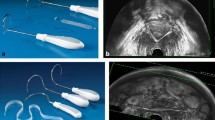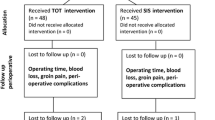Abstract
Introduction and hypothesis
The aim of this study was to evaluate the functional outcome of a single-incision sling procedure for the treatment of female stress urinary incontinence (SUI) and to correlate the cure rate with a pelvic floor ultrasound examination
Methods
Fifty-seven patients treated with a single-incision sling procedure between January 2009 and September 2010 were included in the study. Functional outcome was evaluated as objective cure rate assessed with stress test and subjective cure rate determined by the International Consultation on Incontinence-Short Form and Patient Global Impression of Improvement scores. Women underwent perineal ultrasound examination by a combined 2D translabial and 3D transvaginal approach to assess bladder neck and tape mobility, tape position along the urethral axis, and tape anchorage. According to the position of self-fixating tips, we divided patients into group A (both tips crossed the obturator membrane), group B (only one tip crossed the obturator membrane) and group C (none of the tips crossed the obturator membrane). Objective cure rate and type of anchorage were compared with all ultrasound parameters.
Results
At an average follow-up of 13 months objective cure rate was 87.7 % with a significant subjective improvement. A significant difference in tape mobility was noted between group A and group C. Bladder neck mobility significantly increased in failures. Sling was significantly closer to mid-urethra in cured than in failures.
Conclusions
In 77 % of patients MA didn’t reach the obturator membrane on both sides. This feature conditioned significantly bladder neck mobility but not the efficacy of the procedure. Tape position seems to be the most important factor for success.






Similar content being viewed by others
Abbreviations
- SUI:
-
Stress urinary incontinence
- SIS:
-
Single incision sling
- BMI:
-
Body mass index
- TVT:
-
Tension-free vaginal tape
- TOT:
-
Transobturator tape
- ICIQ-SF:
-
International Consultation on Incontinence Questionnaire-Short Form
- PGI-I:
-
Patient Global Impression of Improvement
- ICIQ-UI-SF:
-
International Consultation on Incontinence Questionnaire-Short Form Italian validation
- UJ:
-
Urethrovesical junction
- ICS:
-
International Continence Society
References
Ulmsten U, Enriksson L, Johnson P et al (1996) An ambulatory surgical procedure under local anaesthesia for treatment of female urinary incontinence. Int Urogynecol J 7:81–86
Debodinance P, Delporte P (2009) MiniArc: preliminary prospective study on 72 cases. J Gynecol Obstet Biol Reprod (Paris) 38(2):144–148
Jimenez CJ, Hualde AA, Cebrian Lostal JL, Alvarez BS, Jimenez PJ, Montesino SM, Raigoso OO, Lozano UF, Pinos PM, Gonzalez de Garibay AS (2010) Stress urinary incontinence surgery with MiniArc swing system: our experience. Actas Urol Esp 34(4):372–377
Hogewoning CRC, Ruhe IMC, Bekker MD et al (2012) The MiniArc sling for female stress urinary incontinence: clinical results after 1-year follow up. Int Urogynecol J 23(5):589–595
Haylen BT, de Ridder D, Freeman RM et al (2010) An International Urogynecological Association (IUGA)/International Continence Society (ICS) joint report on the terminology for female pelvic floor dysfunction. Int Urogynecol J 21(1):5–26
Tubaro A, Zattoni F, Prezioso D et al (2006) Italian validation of the International Consultation on Incontinence Questionnaires. BJU Int 97(1):101–108
Yalcin I, Bump RC (2003) Validation of two global impression questionnaires for incontinence. Am J Obstet Gynecol 189(1):98–101
Haylen BT, Frazer MI, Sutherest JR, West CR (1989) Transvaginal ultrasound in the assessment of bladder volumes in women. Preliminary report. Br J Urol 63(2):149–151
Haylen BT (1989) Verification of the accuracy and range of transvaginal ultrasound in measuring bladder volumes in women. Br J Urol 64(4):350–352
Dietz HP, Wilson PD (2004) The “iris effect”: how two-dimensional and three-dimensional ultrasound can help us understand anti-incontinence procedures. Ultrasound Obstet Gynecol 23:267–271
Latthe PM, Foon R, Toozs-Hobson P (2007) Transobturator and retropubic tape procedures in stress urinary incontinence: a systematic review and meta-analysis of effectiveness and complications. BJOG 114(5):522–531
Daneshgari F, Kong W, Swartz M (2008) Complications of mid urethral slings: important outcomes for future clinical trials. J Urol 180(5):1890–1897
Lo TS, Horng SG, Liang CC et al (2004) Ultrasound assessment of mid-urethra tape at three years follow up after TVT procedure. Urology 63:671–675
De Tayrac R, Deffieux X, Resten A et al (2006) A transvaginal ultrasound study comparing transobturator tape and tension-free vaginal tape after surgical treatment of female stress urinary incontinence. Int Urogynecol J 17:466–471
Dietz HP, Mouritsen L et al (2003) Does the TVT stay where you put it? Am J Obstet Gynecol 188:950–953
Dietz HP, Mouritsen L et al (2004) How important is TVT location? Acta Obstet Gynecol Scand 83:904–908
Abdel-Fattah M, Ford JA, Lim CP et al (2011) Single-incision mini-slings versus standard midurethral slings in surgical management of female stress urinary incontinence: a meta-analysis of effectiveness and complications. Eur Urol 60:468–480
Acknowledgements
We want to express our gratitude to Dr Robert Fruscio for his kind and experienced help in reviewing the script.
Conflicts of interest
None.
Author information
Authors and Affiliations
Corresponding author
Rights and permissions
About this article
Cite this article
Spelzini, F., Cesana, M.C., Verri, D. et al. Three-dimensional ultrasound assessment and middle term efficacy of a single-incision sling. Int Urogynecol J 24, 1391–1397 (2013). https://doi.org/10.1007/s00192-012-2031-5
Received:
Accepted:
Published:
Issue Date:
DOI: https://doi.org/10.1007/s00192-012-2031-5




